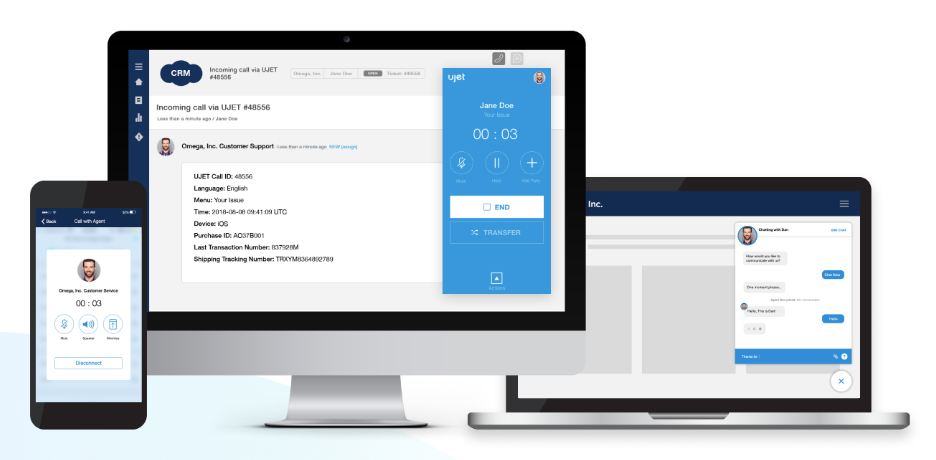Stay updated!
The best customer experience content delivered right to your inbox.
10 Ways to Use Customer Data to Build a Better Customer Support Training Program
by UJET Team |
Proper training gives your team the tools they need to provide an exceptional customer experience. When you incorporate customer data into training programs you’re ensuring that every agent understands how customers actually interact with your team. This makes it easy to anticipate the customer’s needs, understand their feelings, and guide them along the customer journey.
Incorporating relevant customer data into your training programs will help your team improve on the kind of experiences they provide. You can use this data to ramp up new hires faster, solidify the existing knowledge on your team, and inform the planning and execution of new types of training.
With a great contact center solution, you can capture important customer data and use it to make your team better.

We’ll take a look at 10 ways your team can use customer data to create more robust, effective, and personalized training programs.
1. Help surface pain points more easily
Your team will encounter times when a customer is having difficulty with the product on a daily basis. Being able to identify when these experiences occur and knowing how to address them effectively will lead to a better overall experience for the customer.
When you’re onboarding new team members, try setting up a role-play session for them based on one of these common situations. Your new agents will be able to try out new support skills and their partner, preferably a senior member of the support team, can get a better understanding of the customer’s feeling when encountering this problem on their own.

2. Use previous interactions for context
There’s nothing better at illustrating an important point than the transcript of an actual customer interaction. Keeping track of previous support interactions through agent notes, voice recordings, and chat transcripts provides valuable context for your training programs.
Employee training isn’t a one-time thing; it’s an ongoing series of lessons that help each agent grow their knowledge of the product and customer support their best practices. You can use both good and bad customer experiences to illustrate how to respond to different situations in the best way possible.

3. Identify different types of customers through contact volume
Each customer is going to contact your team for different reasons, but it’s easy to identify where someone is in the customer journey based on their historical contact data. Brand new customers will contact your team more often than established customers and people who are thinking about leaving will likely reach out less as they become disengaged with the product.
When training the team on the customer journey, you can include data on typical call volumes based on where a customer is along that journey. While these will vary from customer to customer, it helps provide a framework for how your team thinks about their interactions at different points along the way.

4. Teach proper note-taking with real examples
Even when your contact center solution collects important customer data, there is still a need for comprehensive customer notes. Your agents interact with the customer on a regular basis and their input is valuable at providing insights into overall customer health and experience.
Your agents need to know how to distill this information into an easily digestible and standardized format. Incorporate these best practices into your training program by using actual examples from real customer accounts.

5. Learn to recognize trigger statements with examples
No one likes losing business, but customer churn happens to everyone. It’s important for your team to recognize the kind of statements that identify an unhappy or disengaged customer. Not every customer is going to come out and say how they feel.
Give your team a high-level overview of the words and statements that can signify a lack of satisfaction in the product. You can tag specific call recordings and chat transcripts to show how the customer used these in the course of a conversation as well as best practices for how to respond properly.

6. Show the impact of great support with customer feedback
Providing exceptional customer service requires consistent work from every member of the team, which can be difficult to maintain in the long run. Real customer feedback acts as social proof of how great support impacts the customer experience and can help get buy-in from the team.
Compile great examples of customer feedback and use them in your training to show how an individual interaction affects the larger experience. It’s important to remind your team that their relationship to the customer can have a real impact on their success with the product.

7. Find agents who excel and have them help with training
Sometimes the most effective trainers are members of the team. By tracking average call times, satisfaction scores, and customer feedback surveys, you can find out which members of your team are excelling at providing a great customer experience.
You can build training off these best practices or have the agent sit down with the team directly to talk about their process. Having a small group training for people who are struggling with a specific skill can potentially have more of an impact than a full-fledged team training session.

8. Track the effectiveness of your training with satisfaction scores
Training should improve over time. As your team grows, the product changes, or your customer evolves, it’s important to make sure you’re maintaining the same level of experience. Use internal metrics like satisfaction score, NPS, and CSAT surveys to track the impact of your training over time.
This helps to optimize each individual session as well as the training program as a whole. You can easily track which trainings resonated with your team, which affected the most change on their behavior, and which weren’t as effective as you’d hoped.

9. Set better expectations with volume metrics
Being able to anticipate the inbound volume of chats, calls, and emails on a given day can help ensure that your team is able to provide the best possible experience. It’s especially important to new team members to know what their typical day will look like before going out on the floor full-time.
Set aside time during your training program to walk through what a typical day will look like for new hires. This will inform their expectations regarding inbound contact volume as well as their responsibilities on a day-to-day basis. It also helps alleviate any potential confusion or anxiety during the onboarding process.

10. Boost morale with crazy edge cases
Your agents will be interacting with customers every single day, which can sometimes lead to burnout over time. Everyone will come up against a situation they couldn’t possibly imagine and it’s important that they know they’re not alone in this when a frustrating, difficult, crazy customer problem rears its ugly head.
Make sure to include these edge cases in your training programs. Whether the interaction ended up with a positive outcome or a negative one, your team needs to understand that this is an unfortunate byproduct of their career that everyone has encountered. These edge cases can also help give your team a feeling of solidarity with their peers.

Let customer data work for you
When you’re using customer data to build your training programs, it’s easier to make your training the best it can be. As a supervisor, you’ll be able to give your team the knowledge it needs to be successful, set realistic expectations, and track the effectiveness of your training over time.
Your agents will appreciate the additional information and will be able to grow and learn alongside the customer. Using customer data in training informs your team, making them more effective at providing exceptional customer experiences in any situation.
The best customer experience content delivered right to your inbox.